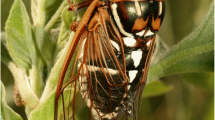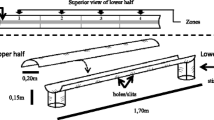Summary
Biosteres longicaudatus Ashmead (Hymenoptera: Bracon dae) is a solitary endoparasite of Anastrepha suspensa larvae (Diptera: Tephritidae), which live in fruit tissue. Larvae make andible noises within macerated fruit or larval medium in which they are reared. Parasite females readily located normal, mobile larvae and spent a mean of 16.5±4.7 min/visit to parasitize these hosts. In contrast, females were unable to locate etherized or dead hosts and abandoned them after only 1.9±0.9 and 2.3±0.8 min, respectively. Females of all ages, with and without oviposition experience, exhibited non-random search and ovipositor probe behaviors in response to artifically created vibration. This response was influenced primarily by the number of mature eggs in the ovaries. These findings suggest that 1) an accumulation of mature eggs in the ovaries increase the appetitive drive of females to find and oviposit in hosts and 2) host sound/vibration produced either by movement of hosts through the medium and/or by the rasping mouth hooks during feeding. is used by parasites as a releaser for host finding behavior as well as a cue to the location of the host within the substrate.
Similar content being viewed by others
References
Carthy JD (1965) The behavior of arthorpods. WH Freeman and Co San Francisco p 1–148
DeLeon D (1935) The biology of Coeloides dendroctoni Cushman, an important parasite of the mountain pine beetle (Dendroctonus monticolae Hopkins). Ann Entomol Soc Am 23:411–424
Greany PD, Ashley TR, Baranowski RM, Chambers DL (1976) Rearing and life history studies on Biosteres (=Opius) longicaudatus (Hym.: Braconidae). Entomophaga 21:207–215
Lathrop FH, Newton RC (1923) The biology of Opius melleus Gaham, a parasite of the blueberry maggot. J Agric Res 46:143–160
Lawrence PO, Baranowski RM, Greany PD (1976) Effect of host age on development of Biosteres (=Opius) longicaudatus, a parasitoid of the Caribbean fruit fly, Anastrepha suspensa. Fla Entomol 59:33–39
Lawrence PO, Greany PD, Nation JL, Baranowski RM (1978) Oviposition behavior of Biosteres longicaudatus, a parasite of the Caribbean fruit fly, Anastrepha suspensa. Ann Entomol Soc Am 71:253–256
Lees AD (1948) Sensory physiology of the sheep tick, Ixodes ricinus. J exp Biol 25:145–207
Richerson JV, Borden JH, Hollingdale J (1972) Morphology of a unique sensillum placodeum on the antenae of Coeloides brunneri. Can J Zool 50:909–13
Ryan RB, Rudinsky JA (1962) Biology and habits of the Douglas-fir beetle parasite, Coeloides brunneri Viereck (Hymenoptera: Braconidae), in western Oregon. Can Entomol 94:748–763
Vinson SB (1976) Host selection by insect parasitoids. Ann Rev Entomol 21:109–133
Author information
Authors and Affiliations
Rights and permissions
About this article
Cite this article
Lawrence, P.O. Host vibration — A cue to host location by the parasite, Biosteres longicaudatus . Oecologia 48, 249–251 (1981). https://doi.org/10.1007/BF00347971
Received:
Issue Date:
DOI: https://doi.org/10.1007/BF00347971




